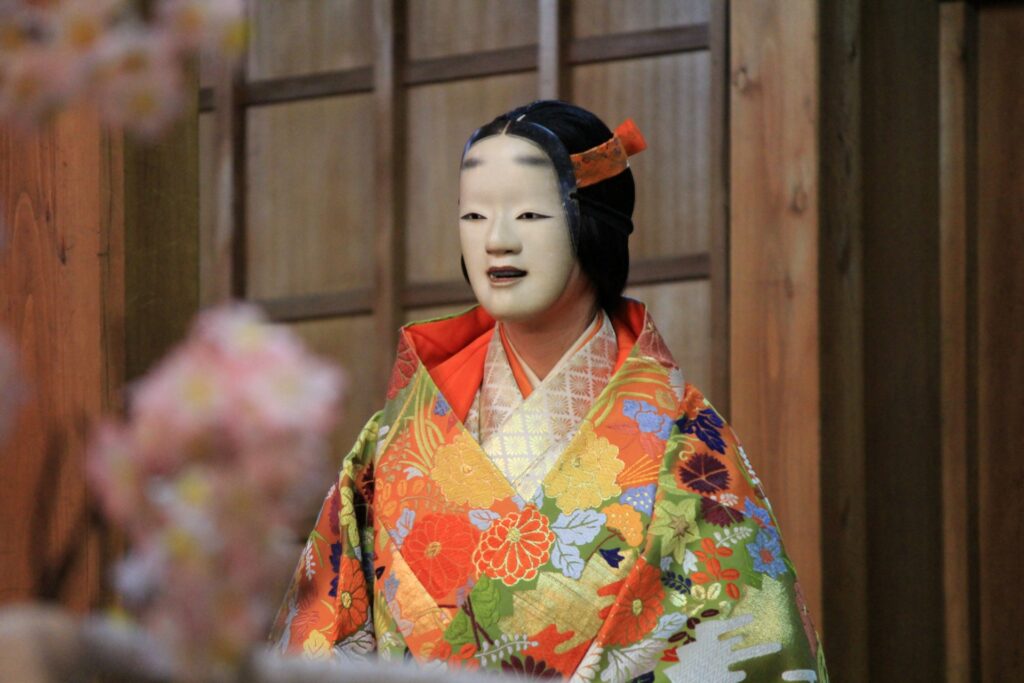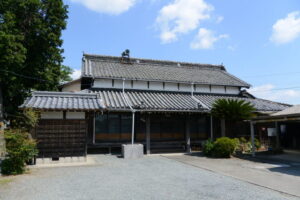Before the clash of swords and the roar of war, there was silence.
In the quiet spaces of Japan’s Noh theater, warriors learned not only how to fight—but how to feel, reflect, and pray.
More than performance, Noh was moral instruction wrapped in poetry and shadow, teaching a code of strength balanced by grace.
As we enter a new age shaped by AI and rapid change, these lessons return to us—not as echoes of a lost world, but as timeless truths for our future.

🌸1. Introduction
When people envision Noh, they often picture a masked figure moving with elegant slowness across a minimalist stage—an art form shrouded in shadows, silence, and what the West has come to associate with wabi-sabi and yūgen.
It is seen as ethereal, elusive, and refined.
But what if Noh is far more than that?
Beneath its stillness lies a deeper current—a cultural inheritance shaped not only by aesthetic ideals, but by the ethical and spiritual needs of Japan’s warrior class.
To the samurai, Noh was not simply a contemplative art.
It was a discipline of the soul: a space where virtue was rehearsed, human emotion was examined, and moral strength was quietly formed.
In its measured pace and poetic language, Noh became a mirror in which warriors saw not just their roles, but their responsibilities.
To understand the heart of Bushidō—the Way of the Warrior—we must look again into the world of Noh, not as a distant relic of beauty, but as a living source of wisdom.
🌸2. Body 1: The Hidden Role of Noh in Samurai Life
Why did the samurai hold Noh in such high regard?
In the modern age, Noh is often described as an aesthetic experience—refined, mysterious, and beautifully restrained.
It is praised for its subtle grace and its evocation of the unseen.
But in feudal Japan, Noh served a role far beyond visual or spiritual delight.
It was woven into the very fabric of samurai life.
Most performances took place not on public stages, but within the secluded walls of castles.
Only on rare occasions—perhaps once a year—were the common people allowed to witness a Noh performance. When that chance came, they lined the streets, eager to catch a glimpse of what the lords and warriors saw so often.
This raises a question:
Why was this art reserved for those who bore arms and served power?
What did the warrior class gain from this slow-moving, highly stylized form of drama?
To answer that, we must look beneath the masks and measured gestures.
We must ask: What truths did Noh reveal to the samurai—not just about the world, but about themselves?
🌸3. Body 2: Historical Realities and Cultural Lessons
To the samurai, Noh was never mere entertainment.
It was a stage not for spectacle, but for reflection—a quiet theatre of ethics.
Beneath its masks and measured gestures lay teachings that shaped the character of those who held the sword.
These teachings were conveyed not through lectures or commandments, but through stories—simple in form, yet rich in meaning.
Let us look more closely at three representative plays that illuminate the moral vision within Noh.
Yuya: Leadership and the Listening Heart
The play Yuya unfolds in the court of Taira no Munemori, a powerful military leader of the late Heian period.
Yuya, a graceful court lady from Enshū, serves him with quiet dignity. One day, word arrives that her mother has fallen gravely ill. She asks for leave to return home and care for her, but Munemori refuses—preferring that she join him for cherry blossom viewing at Kiyomizu Temple.
On the day of the outing, as the flowers bloom in full glory, a sudden spring rain scatters the petals.
To some, this may seem like chance. But to those attuned to signs, it is read as a divine message from the gods of Kiyomizu—a sign that empathy must prevail.
Yuya does not raise her voice. She offers no protest. Instead, she writes a gentle waka:
“Though the spring in the capital is hard to leave,
might the flowers of my distant eastern home be falling now…”
These words—soft yet filled with longing—touch Munemori more deeply than any plea. He grants her leave to return home.
This play offers a profound insight:
That true leadership is not rigid. It listens. It feels.
Yuya does not resist authority, yet her sorrow is heard—not through confrontation, but through poetry.
Power, when tempered by empathy, becomes wisdom.
Matsukaze: The Weight of a Promise
In Matsukaze, we meet two sisters—Matsukaze and Murasame—sea maidens who once tended to the exiled noble Ariwara no Yukihira.
Their time with him was short, but meaningful. When he departed, he left behind a poem:
“Though we must part now,
if I hear you still wait for me at Mount Inaba,
I shall return to you.”
The sisters wait. And time passes. Nearly two hundred years.
Their bodies wither and die, but their souls remain—bound to that place, still waiting for Yukihira’s return.
By now, the house where they once lived has fallen into ruin. Nothing remains but stones and memory.
One day, a traveling monk passes through the area.
He senses their presence, hears their sorrowful tale, and offers prayers and sacred sutras.
Only then do their spirits find peace, and finally ascend to the next world.
What does this teach?
That for those without power, a single word from the powerful can shape an entire lifetime—or even an afterlife.
Noh reminded the warrior class that their speech carried weight, and that honor begins not with action, but with the words they choose to speak.
Nue: Justice with Mercy
The play Nue tells of a terrifying beast—its head that of a monkey, body of a tiger, and tail of a snake—that once plagued the imperial palace.
Minamoto no Yorimasa, a great archer and warrior, slays the monster with precision.
But while its body perishes, its soul wanders, tormented and forgotten.
Years later, a monk traveling through the mountains encounters the ghost.
“Who are you?” he asks.
“I was the Nue,” comes the tearful reply. “I was destroyed for my sins, but no one has prayed for my soul.”
The monk offers sutras and compassion. The spirit weeps, bows deeply, and at last, is released into the Pure Land.
Here, Noh offers a unique teaching:
Justice demands that evil be defeated—but not hated.
Even a foe, once fallen, deserves to be mourned.
The warrior’s duty does not end at the blade. It continues in mercy, prayer, and the quiet work of healing the world.
Conclusion of the Section
These stories did not entertain.
They instructed.
They asked samurai not only to act with strength, but to feel with depth.
To master a sword is one thing. To master the self—that was the true pursuit.
And in the silence of Noh, warriors heard the clearest lessons of all.
🌸4. Body 3: Interpretation and Insight
Noh was more than a cultural pastime for the samurai.
It was a mirror for leadership, a quiet classroom for moral formation, and a ritual to keep power in check.
In its poetic language and stylized movements, it whispered truths that could not be shouted on battlefields.
Unlike Kabuki, which grew from the towns and often celebrated energy, passion, and satire, Noh was rooted in stillness and introspection.
It taught the warrior class that to hold a sword was not only to wield power, but to bear responsibility.
Where Kabuki entertained, Noh instructed.
Where Kabuki provoked, Noh purified.
Noh’s dialogues, known as yōkyoku, shaped the speech patterns of the samurai elite.
In an age where dialects divided domains, the shared language of Noh helped unify warriors from distant provinces in the capital.
This linguistic unity reinforced not only communication, but a sense of shared identity and moral vocabulary.
Within castle walls, Noh was not mere entertainment.
It was ceremony.
Feudal lords would gather not as passive spectators, but as seekers of wisdom.
Each performance became an act of renewal—a moment to reconnect with the weight of command, the fragility of life, and the duty to lead with dignity.
Through these stories, Noh became a means of moral cultivation.
It taught restraint to the powerful, empathy to the armed, and perspective to those who walked the razor’s edge of life and death.
Rather than glorifying violence or victory, it offered moments of stillness where warriors could reflect on loss, justice, and what it means to be truly strong.
🌸5. Conclusion: Echoes of Bushidō in a Changing World
Noh, with its quiet gestures and poetic restraint, was more than art—it was a moral compass for an age defined by war.
Through the lives and afterlives of warriors, lovers, spirits, and monsters, it offered a philosophy:
that power must bow to empathy, that victory demands reflection, and that even enemies deserve dignity in death.
Today, as we enter an age transformed by artificial intelligence, these ancient lessons gain new urgency.
AI forces us to confront anew the question of what it means to be human—what empathy, resonance, and coexistence truly require.
In this context, the moral teachings embedded in Noh—the compassion of a commander for his retainer, the grief of women separated from family, the importance of a single sincere word, and the responsibility to honor even fallen foes—shine as timeless wisdom.
Noh reminds us that leadership is not measured by dominance, but by depth.
Strength lies not in control, but in care.
And true civilization is not built upon conquest, but upon communion—with others, with ourselves, and with the spirits of the past.
As we walk into an uncertain future, let us carry the legacy of Noh not as relic, but as guide.
The stage may have been silent, but its voice still speaks—softly, solemnly, and with truth that endures.


